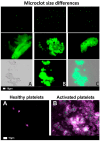Fibrinaloid Microclots and Atrial Fibrillation
- PMID: 38672245
- PMCID: PMC11048249
- DOI: 10.3390/biomedicines12040891
Fibrinaloid Microclots and Atrial Fibrillation
Abstract
Atrial fibrillation (AF) is a comorbidity of a variety of other chronic, inflammatory diseases for which fibrinaloid microclots are a known accompaniment (and in some cases, a cause, with a mechanistic basis). Clots are, of course, a well-known consequence of atrial fibrillation. We here ask the question whether the fibrinaloid microclots seen in plasma or serum may in fact also be a cause of (or contributor to) the development of AF. We consider known 'risk factors' for AF, and in particular, exogenous stimuli such as infection and air pollution by particulates, both of which are known to cause AF. The external accompaniments of both bacterial (lipopolysaccharide and lipoteichoic acids) and viral (SARS-CoV-2 spike protein) infections are known to stimulate fibrinaloid microclots when added in vitro, and fibrinaloid microclots, as with other amyloid proteins, can be cytotoxic, both by inducing hypoxia/reperfusion and by other means. Strokes and thromboembolisms are also common consequences of AF. Consequently, taking a systems approach, we review the considerable evidence in detail, which leads us to suggest that it is likely that microclots may well have an aetiological role in the development of AF. This has significant mechanistic and therapeutic implications.
Keywords: Long COVID; arrhythmias; atrial fibrillation; fibrinaloid microclots; infection; inflammation; particulate matter; pollution.
Conflict of interest statement
E.P. has a patent on the use of fluorescence methods for the detection of microclots in Long COVID. The authors declare no other conflicts on interest.
Figures







References
-
- Chugh S.S., Havmoeller R., Narayanan K., Singh D., Rienstra M., Benjamin E.J., Gillum R.F., Kim Y.H., McAnulty J.H., Jr., Zheng Z.J., et al. Worldwide epidemiology of atrial fibrillation: A Global Burden of Disease 2010 Study. Circulation. 2014;129:837–847. doi: 10.1161/CIRCULATIONAHA.113.005119. - DOI - PMC - PubMed
-
- Corica B., Bonini N., Imberti J.F., Romiti G.F., Vitolo M., Attanasio L., Basili S., Freedman B., Potpara T.S., Boriani G., et al. Yield of diagnosis and risk of stroke with screening strategies for atrial fibrillation: A comprehensive review of current evidence. Eur. Heart J. Open. 2023;3:oead031. doi: 10.1093/ehjopen/oead031. - DOI - PMC - PubMed
Publication types
LinkOut - more resources
Full Text Sources
Miscellaneous

